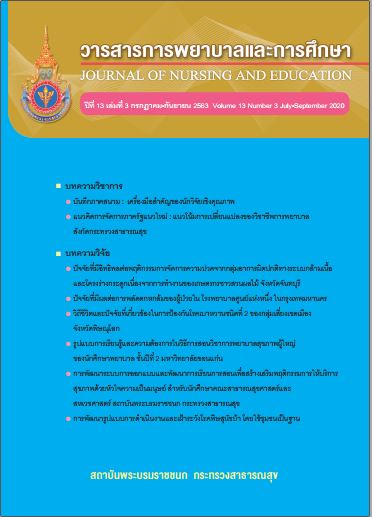วิถีชีวิตและปัจจัยที่เกี่ยวข้องในการป้องกันโรคเบาหวาน ชนิดที่ 2 ของกลุ่มเสี่ยงเขตเมือง จังหวัดพิษณุโลก
Lifestyle and Related Factors that Prevention Diabetes Type 2 in the Pre-Diabetes Group of Phitsanulok Province.
คำสำคัญ:
วิถีชีวิตเขตเมือง, การป้องกันโรคเบาหวานชนิดที่ 2, กลุ่มเสี่ยงโรคเบาหวานบทคัดย่อ
โรคเบาหวานชนิดที่ 2 เป็นปัญหาสุขที่สำคัญของทั่วโลก เป็นชนิดที่พบบ่อยถึงร้อยละ 95 ของผู้ป่วยเบา
หวานทั้งหมดเป็นผลมาจากการดื้อต่ออินซูลิน ร่วมกับความบกพร่องในการผลิตอินซูลินที่เหมาะสมซึ่งมีผล
กระทบต่อคุณภาพชีวิตของผู้ป่วยและครอบครัว การวิจัยเชิงคุณภาพครั้งนี้มีวัตถุประสงค์เพื่อศึกษาวิถีชีวิตและ
ปัจจัยที่เกี่ยวข้องในการป้องกันโรคเบาหวานชนิดที่ 2 ของกลุ่มเสี่ยงอำเภอเมือง จังหวัดพิษณุโลก ผู้ให้ข้อมูล
หลักที่มีคุณสมบัติตามเกณฑ์การคัดเข้าประกอบไปด้วย กลุ่มเสี่ยง ครอบครัวกลุ่มเสี่ยง เจ้าหน้าที่สาธารณสุข
และผู้นำชุมชน จำนวน 28 คน ดำเนินการสัมภาษณ์เชิงลึกโดยใช้แบบสัมภาษณ์ชนิดกึ่งโครงสร้าง ร่วมกับการ
สังเกตแบบไม่มีส่วนร่วม และการบันทึกเสียง วิเคราะห์ข้อมูลแบบเชิงประเด็น
ผลการวิจัยพบว่า การป้องกันโรคเบาหวานชนิดที่ 2 ในกลุ่มเสี่ยงเขตอำเภอเมือง จังหวัดพิษณุโลก
ประกอบไปด้วย 1) บริบทใหม่ทางสังคมและสิ่งแวดล้อมที่ส่งผลกระทบต่อวิถีชีวิตและสุขภาพ 2) ปัจจัยที่เป็น
อุปสรรค ได้แก่พฤติกรรมการรับประทานอาหาร พฤติกรรมการออกกำลังกาย และ 3) ปัจจัยสนับสนุน ได้แก่
แรงสนับสนุนทางสังคมจากครอบครัว ชุมชน และบุคลากรทางด้านสุขภาพ โดยประเด็นที่ได้จากการศึกษาการ
ศึกษาครั้งนี้สอดคล้องกับการศึกษาที่ผ่านมา ดังจะเห็นได้ว่าวิถีชีวิตในชุมชนเมือง พฤติกรรมการรับประทานอาหาร พฤติกรรมการออกกำลังกายและแรงสนับสนุนทางสังคมเป็นปัจจัยที่เกี่ยวข้องในการป้องกันโรคเบาหวาน
ชนิดที่ 2 ในกลุ่มเสี่ยง
`สรุป: การวิจัยเชิงคุณภาพครั้งนี้พบว่าวิถีชีวิตของกลุ่มเสี่ยงเขตเมืองในการเข้าถึงการบริโภคอาหารทา
งออน์ไลน์หรือเดลิเวอร์รี่ฟูด มีผลต่อพฤติกรรมในการป้องกันโรคเบาหวานชนิดที่ 2 ดังนั้นผลวิจัยที่ได้สามารถ
นำไปเป็นแนวทางในการสร้างรูปแบบการป้องกันโรคเบาหวานชนิดที่ 2 โดยรูปแบบจะมีกิจกรรมที่มีความเหมาะ
สมและปรับให้เข้ากับวิถีชีวิตของกลุ่มเสี่ยงในเขตเมือง
เอกสารอ้างอิง
2. Centers for Disease Control and Prevention:
CDC, (on line) 2019; [cited 2019/11/22].
Available from:http://gis.cdc.gov/grasp/diabetes/Diabetes Atlas.
3. American Diabetes Association. Diagnosis and
Classification of Diabetes Mellitus. Diabetes
Care 2014;37(1):81–90.
4. The National Institute of Diabetes and Digestive
and Kidney Diseases .Pre-Diabetes Facts and
Statistics. (on line) 2019 [cited 2019/12/12].
Available from: https://www.niddk.nih.gov/
health-information/health-statistics/diabetesstatistics
5. Aekplakorn W, Chariyalertsak S, Kessomboon
P, Assanangkornchai S, Taneepanichskul S,
Putwatana P. Prevalence of Diabetes and
Relationship with Socioeconomic Status in the
Thai Population: National Health Examination
Survey, 2004-2014. Journal of diabetes Research. 2018:1-7 (on line) [cited 2019 /11/
22]. Available from: https://www.hindawi.com/
journals/jdr/2018/1654530/
6. Phitsanulok Provincial Health Office. HDC System. (on line) [cited 2019 /11/ 22]. Available
from: http://203.157.118.7/chronic/index.php.
7. Centers for Disease Control and Prevention.
Pre-Diabetes: Your Chance to Prevent Type 2
Diabetes. [cited 2019 /11/ 2]. Available from:
https://www.cdc.gov/diabetes/basics/prediabetes.html
8. Plegthikarnkid T. Community Context under
the Semi-Urban, Semi-Rural Society. Journal of
Fareastern University (2017); 9(1): 7-15.
9. Karoonngamphan M,. Suvaree S., Numfone N,.
Health Behaviors and Health Status of Workers: A Case Study of Workplaces in Sathorn
District,Bangkok Metropolitan. Songklanagarind
Journal of Nursing (2012); 32(3): 51-66. .(in
Thai)
10. Sikaow O., Namjuntra R., Trakulsithichok S.
Factors Associated with Glycemic Control in
Type 2 Diabetic Patients at Hua-Chiew Hospital. Journal of The Royal Thai Army Nurses
(2013); 14(3): 39-49. (in Thai)
11. Glaser, B.G & Strauss, A.L. The Discovery of
Grounded Theory: Strategies for Qualitative
Research (1967). Chicago: Aldine Publishing
Company.
12. Intharabut M., Muktabhant B. Perception and
Practices of Dietary Control in Type 2 Diabetic Patients. Srinagarind Med J. (2007);
22(3), 283-290. .(in Thai)
13.Tepsuriyanont, S., Chaichanawirot,U., Dietary
Control Behavior among Controlled and Uncontrolled Plasma Glucose Level of Diabetic
Patient. Journal of Nursing and Education,
2018;11(1):32-49.(in Thai)
14. Malatham P., Phromkong P., & Intarasombat
P. Level Prediction Factor Blood Sugar of the
Elderly with Type 2 Diabetes 2. Ramathibodi
Hospital,2010; 16 (2), 218-237. .(in Thai)
15. Seepiboonbat J.,Suksawan T., and Sinakom
T., The Effect of Health behavior Modification
Program on the Blood Glucose and HbA1c
Level among Diabetic Patients Sawanpracharak Hospital. Journal of Nursing and Education,2002;13(2). 47-59. (in Thai)
16. Chuenwattana W. & Sonphakdee N. Self-Care
Behavior of Patients. Diabetes. Academic journal Pathum Thani University, 2014; 6 (3),
163-170.(in Thai)






